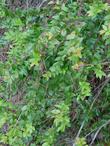Vaccinium ovatum
Huckleberry.
Huckleberry, Vaccinium ovatum, is a 2-3 ft. evergreen shrub that has 1/4" blue berries. (Ok, ok, sometimes Huckleberry will grow to 5-6 feet and have 1/2 inch berries in coastal forest.) I have seen this one in four locations so far. One is in our co. in sand in one of the foggiest places I know of. Another was in the mountains above Big Sur in clay and in full sun (it was not big, nor did it look good). The third was on an old 1000ft sand dune above Santa Cruz. It was 3-5ft tall and covered with berries. At that location it was growing in a fairly hot and dry part-shade location in pure sand. It was growing next to Arctostaphylos tomentosa and under Pinus ponderosa, Pseudotsuga menziesii, Quercus agrifolia, Quercus chrysolepis, and Quercus wislizenii. The fourth was in Ft. Bragg where it was associated with Arctostaphylos nummularia, Arctostaphylos coluumbianum, Gaultheria shallon, Ledum glandulosa, and Rhododendron occidentale. It looked like a tropical rain forest. All the sites are highly acidic and low in organic matter. They usually have 1" of organic duff on top of inorganic soils. This plant is hard to grow out of its soil type or climate range. It commonly freezes here (at 0F) in the winter and fries in the summer(at 110+). We have found a spot it has done fairly well on a north wall in a foot of cedar saw dust (as mulch).
In a California garden plant it in moist shade with plants like Carpenteria californica, Rhododendron occidentale, Heuchera micrantha, Satureja douglasii, and Ribes sanguineum glutinosum.
Vaccinium ovatum tolerates sand and clay.
Foliage of Vaccinium ovatum has color reddish-green and is evergreen.
Flower of Vaccinium ovatum has color white.
Fruit of Vaccinium ovatum is edible.
Communities for Vaccinium ovatum:Closed-cone Pine Forest, Coastal Sage Scrub, Douglas Fir Forest and Redwood Forest.
| ph: | 4.00 to 6.00 |
|---|---|
| usda: | 7 to 10 |
| height[m]: | 0.50 to 1.00 |
| width[m]: | 0.50 to 1.00 |
| rainfall[cm]: | 65.00 to 281.00 |






